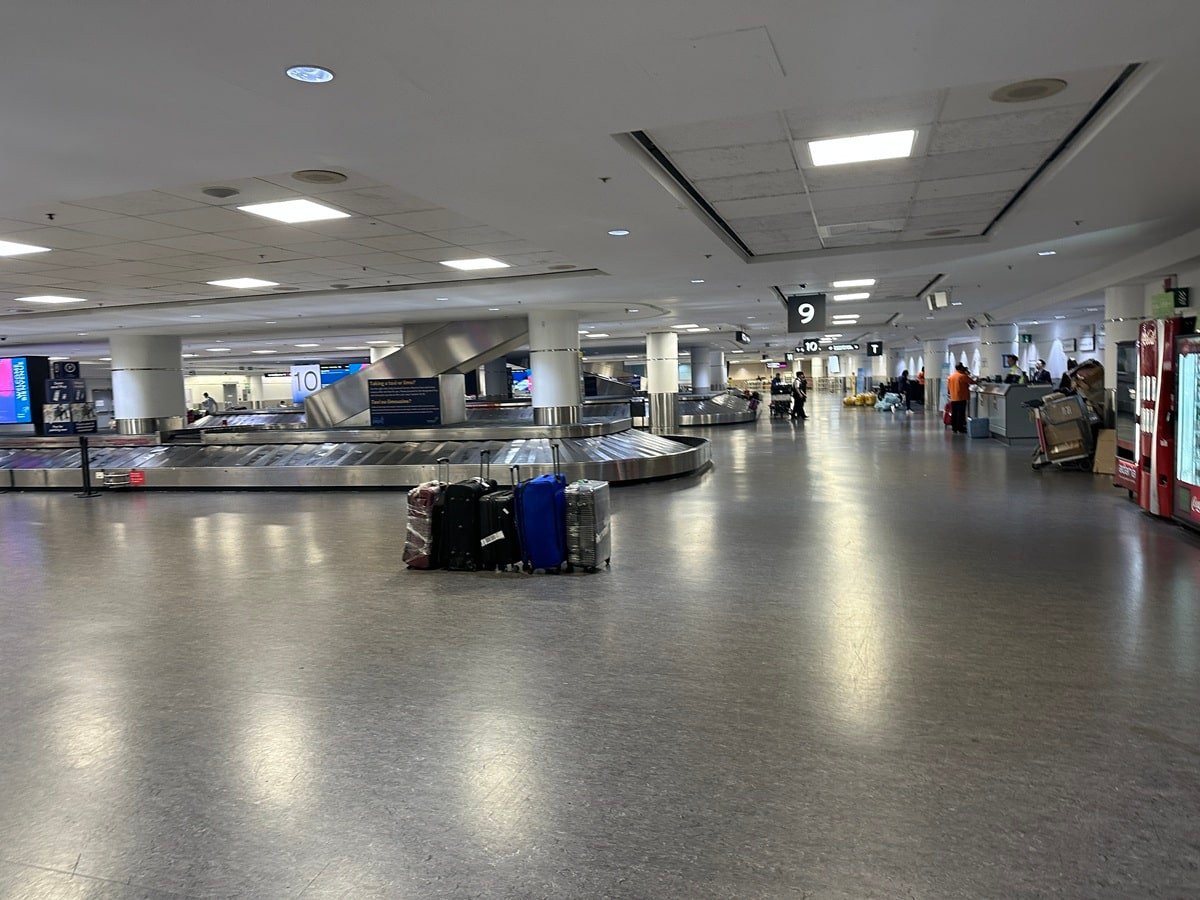In December, a video of severe turbulence on a flight to Hawaii went viral as dozens of passengers were injured. The incident understandably made many travelers nervous, including me, since I was flying to the islands a couple of weeks later. (Here’s my LAX-Maui trip report; I’m happy to say the flight was very smooth). RELATED: How Do Pilots Identify and Avoid Areas of Turbulence
 I’ve been getting questions from readers and friends about flying through turbulence and I can definitely relate as I used to be afraid to fly. And any time my plane hit turbulence, my fear exponentially got worse. Fortunately, I’ve come to realize that planes are safe even in severe turbulence, as long as passengers and crew have their seatbelts on. But I still don’t want to fly in it, nor do most people. Believe it or not, one of my good friends, shockingly enjoys a bumpy ride. To each their own, as they say.
I’ve been getting questions from readers and friends about flying through turbulence and I can definitely relate as I used to be afraid to fly. And any time my plane hit turbulence, my fear exponentially got worse. Fortunately, I’ve come to realize that planes are safe even in severe turbulence, as long as passengers and crew have their seatbelts on. But I still don’t want to fly in it, nor do most people. Believe it or not, one of my good friends, shockingly enjoys a bumpy ride. To each their own, as they say.
But before I give you some info on how to find out if your flight is going to be turbulent, I thought I would share some comforting words from our resident pilot, Spencer, who works for a major commercial airline.
He says: “Pilots go to great lengths to ensure our passengers have an enjoyable experience on our airplane. One of the most perceptible ways we do that is by providing a smooth flight. Turbulence is something that no passenger likes to experience and pilots have many tools at their disposal to make their flight as smooth as possible.”
It’s also important to know that “airplanes are designed from the start to withstand the stress of the roughest air. Check out the video below from Airbus to see exactly how much stress a jetliner can handle.”

Where is turbulence most common?
Since turbulence has been on so many readers’ minds and for some time, I thought some of Spencer’s most popular questions would be appreciated. Such as: Where is turbulence most common? Spencer says: “Pretty much any airport and any airspace can contain turbulence depending on the weather conditions that exist at a given time. That may include gusty winds at the airport’s surface to thunderstorms and frontal systems along an airplane’s flight path. Pilots are notified of these conditions in advance so they may be avoided or mitigated. That being said, there are some geographic areas where pilots can regularly expect a rough ride. Flying into airports in mountainous areas, pilots can regularly expect to find turbulence. This is due to wind blown across the ground interacting with terrain features and causing turbulent air. Aircraft flying into airports like Las Vegas, Denver and Salt Lake City often experience turbulence during their initial climb and approaches to landing. It generally only lasts for a few minutes while the aircraft is close to the ground.”
How do pilots identify and avoid areas of turbulence?
Another popular question for Spencer: How do pilots identify and avoid areas of turbulence? Spencer says, “Turbulence is something that is unique to aviation. Unlike freeway driving, where potholes and bumps in the road are easily visible, determining areas of rough air is more challenging as they don’t always present themselves visibly to pilots. Nonetheless, pilots do have tools and experiential knowledge to prevent an inadvertent encounter with rough air. Pilots are capable of identifying areas of potential turbulence by using their knowledge of meteorology and weather patterns. One of the simplest ways we avoid turbulence is by avoiding areas with thunderstorms. Convective activity is associated with unstable air, as well as strong updrafts and downdrafts. This type of tumultuous atmosphere always leads to bumps. So pilots will make every effort to avoid them.
How to find out if your flight is going to be turbulent
Before I fly, I always look at the weather to see what to pack (obviously) but I also check to see if there’s going to be a storm or high winds. Usually, when there are high winds at your destination, you can bet that at least on descent, it will be bumpy. If you want to take it one step further, you can look at free turbulence forecast maps provided by TurbulenceForecast.com.
They have two:
–Turbulence Advisories
–Pilot Reports (PIREPs) of Turbulence
Turbulence Forecast also offers a personalized forecast 2-12 hours before your flight for $14.99. I’ve never done it but I’m sometimes tempted.
The app that helps you deal with turbulence
There’s also a cheaper option by Turbcast. It’s an iOS-only app ($1.99) designed for people with a mild fear of flying, as well as anyone looking for a better understanding of turbulence. The app looks at the same aviation weather that pilots look at to give you a realistic prognosis of the skies and bumps that may be ahead. You can see turbulence embedded in thunderstorms as pilots see it. Turbcast was designed by an airline pilot and uses a combination of aviation knowledge and NLP Neuro Linguistic Programming techniques to help you reduce your fear of turbulence. Turbcast is easy to use. Simply enter your departure and arrival airports and time zone—that’s it. Coverage works only in the USA, Mexico, Canada, the UK, Western Europe, and a few countries in the Caribbean (Cuba, Dominican Republic, St Lucia, and Trinidad).
Overcoming turbulence fears
On a related note, since most people who are worried about turbulence are usually afraid to fly, I thought I would share this NBC News story by correspondent Jeff Rossen. He featured an unexpected trick that can help you overcome turbulence fears: writing your name with your “off” hand. Rossen’s producer (who’s afraid to fly) tries it out in the segment and finds it effective. The idea is that the activity requires enough focus to pull your attention away from the situation around you, and that, according to the pilot who explains it, it “cross[es] over [your] motor functions.” He shared other tricks as well, which you can read here.
What to do if you’re in the bathroom during severe turbulence
Jeff Rossen did another investigative piece on how to stay safe when severe turbulence hits your plane. One of the tips I took away is that if you’re in the bathroom when the plane starts experiencing severe turbulence, you shouldn’t run back to your seat (yeah, that’s what I would’ve done before seeing this). Instead, flight attendants recommend you sit on the toilet and brace yourself until it passes.
Fasten your seatbelt
It’s important to remember Spencer’s words: “Turbulence is something pilots and passengers alike would prefer to avoid. However, to enable travel to certain parts of the globe, airplanes must traverse areas where turbulence is common. Nonetheless, with today’s modern aircraft and understanding of meteorology, turbulence is more of a nuisance than a safety hazard. But remember, if your crew does turn on the “Fasten seatbelt” sign, please take your seat and buckle up.”
KEEP READING:
–8 Ways To Make Sure An Airline Doesn’t Lose Your Bag … And That You Don’t Get Robbed or Stalked
–The Trick For Getting Airport Luggage Carts for Free
–Airline Lost Your Luggage? Do This If You Want to Get Compensated
–Why Frequent Fliers Use Apple AirTags or Samsung SmartTags When They Travel
–An Airline Executive’s Number One Tip for Avoiding Lost Luggage When You Fly
Want more travel news, tips and deals? Sign up here for Johnny Jet’s Daily Travel Tip newsletter! Just fill in your email address and check the Daily Travel Tip box—and you’ll have Johnny’s best tips, straight to your inbox each day!



